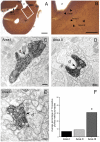The dopamine D2 receptor gene in lamprey, its expression in the striatum and cellular effects of D2 receptor activation
- PMID: 22563388
- PMCID: PMC3338520
- DOI: 10.1371/journal.pone.0035642
The dopamine D2 receptor gene in lamprey, its expression in the striatum and cellular effects of D2 receptor activation
Abstract
All basal ganglia subnuclei have recently been identified in lampreys, the phylogenetically oldest group of vertebrates. Furthermore, the interconnectivity of these nuclei is similar to mammals and tyrosine hydroxylase-positive (dopaminergic) fibers have been detected within the input layer, the striatum. Striatal processing is critically dependent on the interplay with the dopamine system, and we explore here whether D2 receptors are expressed in the lamprey striatum and their potential role. We have identified a cDNA encoding the dopamine D2 receptor from the lamprey brain and the deduced protein sequence showed close phylogenetic relationship with other vertebrate D2 receptors, and an almost 100% identity within the transmembrane domains containing the amino acids essential for dopamine binding. There was a strong and distinct expression of D2 receptor mRNA in a subpopulation of striatal neurons, and in the same region tyrosine hydroxylase-immunoreactive synaptic terminals were identified at the ultrastructural level. The synaptic incidence of tyrosine hydroxylase-immunoreactive boutons was highest in a region ventrolateral to the compact layer of striatal neurons, a region where most striatal dendrites arborise. Application of a D2 receptor agonist modulates striatal neurons by causing a reduced spike discharge and a diminished post-inhibitory rebound. We conclude that the D2 receptor gene had already evolved in the earliest group of vertebrates, cyclostomes, when they diverged from the main vertebrate line of evolution (560 mya), and that it is expressed in striatum where it exerts similar cellular effects to that in other vertebrates. These results together with our previous published data (Stephenson-Jones et al. 2011, 2012) further emphasize the high degree of conservation of the basal ganglia, also with regard to the indirect loop, and its role as a basic mechanism for action selection in all vertebrates.
Conflict of interest statement
Figures







Similar articles
-
Dopamine differentially modulates the excitability of striatal neurons of the direct and indirect pathways in lamprey.J Neurosci. 2013 May 1;33(18):8045-54. doi: 10.1523/JNEUROSCI.5881-12.2013. J Neurosci. 2013. PMID: 23637194 Free PMC article.
-
Ultrastructural localization of D2 receptor-like immunoreactivity in midbrain dopamine neurons and their striatal targets.J Neurosci. 1994 Jan;14(1):88-106. doi: 10.1523/JNEUROSCI.14-01-00088.1994. J Neurosci. 1994. PMID: 7904306 Free PMC article.
-
Evolutionarily conserved organization of the dopaminergic system in lamprey: SNc/VTA afferent and efferent connectivity and D2 receptor expression.J Comp Neurol. 2014 Dec 1;522(17):3775-94. doi: 10.1002/cne.23639. Epub 2014 Jun 27. J Comp Neurol. 2014. PMID: 24942187
-
Striatal D2 receptors and LTD: yes, but not where you thought they were.Neuron. 2006 May 4;50(3):347-8. doi: 10.1016/j.neuron.2006.04.023. Neuron. 2006. PMID: 16675388 Review.
-
The lamprey blueprint of the mammalian nervous system.Prog Brain Res. 2014;212:337-49. doi: 10.1016/B978-0-444-63488-7.00016-1. Prog Brain Res. 2014. PMID: 25194205 Review.
Cited by
-
Olfactory Projections to Locomotor Control Centers in the Sea Lamprey.Int J Mol Sci. 2024 Aug 29;25(17):9370. doi: 10.3390/ijms25179370. Int J Mol Sci. 2024. PMID: 39273317 Free PMC article.
-
The neural bases of vertebrate motor behaviour through the lens of evolution.Philos Trans R Soc Lond B Biol Sci. 2022 Feb 14;377(1844):20200521. doi: 10.1098/rstb.2020.0521. Epub 2021 Dec 27. Philos Trans R Soc Lond B Biol Sci. 2022. PMID: 34957847 Free PMC article.
-
The Dopaminergic Control of Movement-Evolutionary Considerations.Int J Mol Sci. 2021 Oct 19;22(20):11284. doi: 10.3390/ijms222011284. Int J Mol Sci. 2021. PMID: 34681941 Free PMC article. Review.
-
Dopamine differentially modulates the excitability of striatal neurons of the direct and indirect pathways in lamprey.J Neurosci. 2013 May 1;33(18):8045-54. doi: 10.1523/JNEUROSCI.5881-12.2013. J Neurosci. 2013. PMID: 23637194 Free PMC article.
-
Dopaminergic modulation of olfactory-evoked motor output in sea lampreys (Petromyzon marinus L.).J Comp Neurol. 2020 Jan 1;528(1):114-134. doi: 10.1002/cne.24743. Epub 2019 Jul 24. J Comp Neurol. 2020. PMID: 31286519 Free PMC article.
References
-
- Grillner S. Ion channels and locomotion. Science. 1997;278:1087–1088. - PubMed
-
- Graybiel AM. The basal ganglia and chunking of action repertoires. Neurobiol Learn Mem. 1998;70:119–136. - PubMed
-
- Redgrave P, Prescott TJ, Gurney K. The basal ganglia: a vertebrate solution to the selection problem? Neuroscience. 1999;89:1009–1023. - PubMed
-
- Hikosaka O, Takikawa Y, Kawagoe R. Role of the basal ganglia in the control of purposive saccadic eye movements. Physiol Rev. 2000;80:953–978. - PubMed
-
- Grillner S, Hellgren J, Menard A, Saitoh K, Wikstrom MA. Mechanisms for selection of basic motor programs–roles for the striatum and pallidum. Trends Neurosci. 2005;28:364–370. - PubMed
Publication types
MeSH terms
Substances
Grants and funding
LinkOut - more resources
Full Text Sources

